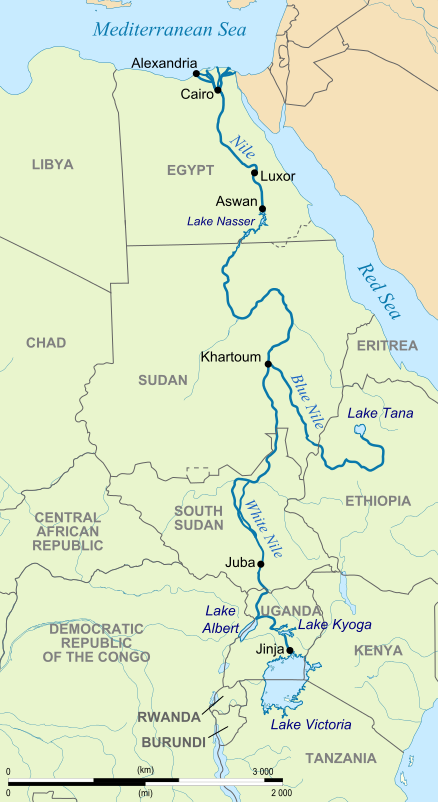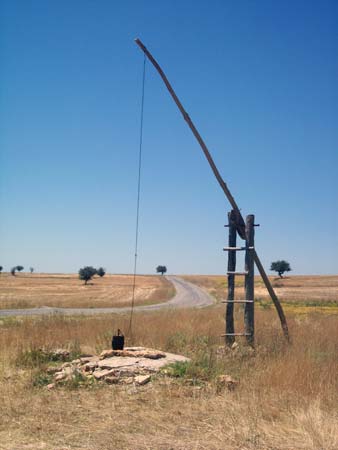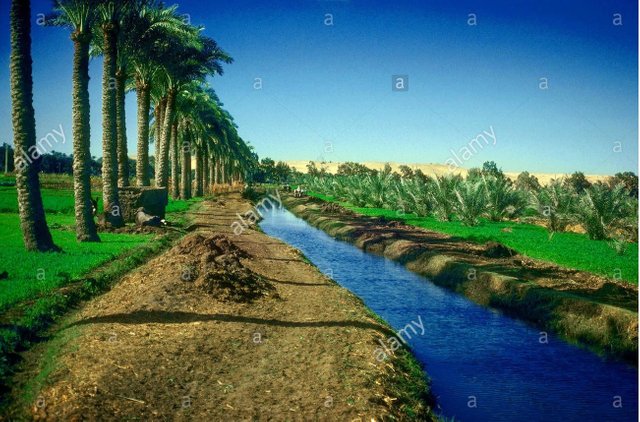Irrigation in the Nile valley
The Nile is regarded as one of the longest rivers (6835km long) on the planet. It drains 12 countries namely, Tanzania, Uganda, Rwanda, Burundi, Congo, Ethiopia, the Democratic Republic of Congo, Sudan, South Sudan, Kenya, Eritrea and Egypt.

Credit
The Nile has two main tributaries namely, the White Nile and Blue Nile. The White Nile is said to be the major stream of the Nile while the Blue Nile is the source of most of the water and silt which is responsible for the alluvial deposits of the Nile valley and the Nile Delta.
The White Nile originates from the Great Lakes region of central Africa and the Blue Nile from from Lake Tana in Ethiopia and flows through Sudan. The White and Blue Nile meets (confluence) in the Khartoum (Capital of Sudan) where it continues flowing through the desert to Egypt where it empties its water into the Mediterranean.
The tributaries of the Nile Include:
- Atbara River
- Blue Nile
- Bahr el Ghazal and Sobat River
- Yellow Nile
Ancient Egypt was indebted to the Nile for its civilization because of its predictability, seasonal flooding and fertile soil, they were credited to be the first groups of people to carry out agriculture on a large scale.
Irrigation in the Nile valley
irrigation simply is the system of farming where water is brought to an otherwise dry farmland in order to make crops grow. The dry and thirsty Nile lands and the Sahelian are most famous in Africa for this type of agriculture.
Both the River Nile itself and the valley through which it flows have certain characteristics which make the area suitable for irrigation.
Three features of the river itself promote irrigation in the Nile valley.
The main river, the White Nile rises from Lake Victoria and flows through the all year round equatorial rainfall region of Uganda. The two main main tributaries, the Blue Nile and Atbara, rise from the heavy orographic summer rainfall region of Ethiopian highlands. These rivers together carry a large volume of water which is used for irrigation downstream.
The level of the River Nile is higher than the surrounding plains for a greater part of its length. In Egypt it is about 1 meter higher. So once a canal is cut from the river, water flows down easily to the farms.
The cutting of the Jonglei canal has diverted the waters of the Nile from the Sudd region in Sudan, where they formerly spread out in the marshes and got lost by evaporation and seepage. The water now flows straight in larger volume through this canal to the river lower down where it is needed for irrigation.
Certain physical conditions of the land surrounding the river also favour irrigation in the Nile valley.
As I have earlier said, the river flows through the semi arid and desert lands of Sudan and Egypt, where rainfall is either scanty, seasonal or unreliable, and therefore water supply for farming scarce. It is only natural then that the waters of this river will be tapped to irrigate the farms around.
The area has gentle slopes, making the construction of irrigation canals relatively easy
The soil profile has clay layer under, over which centuries of Niles flooding has deposited fine silt carried down from the volcanic soils of Ethiopian and Ugandan highlands. The silt enriches the soil, while the clay underneath ensures that the valuable irrigation water is not quickly lost by percolation.
The relative low rainfall in Egypt and Sudan also gives rise to little vegetation. Clearing problems and chances of crop damage by pests and diseases are thereby reduced to minimum.
Humans are also factors, for it is they who decide to irrigate their farms and to adopt appropriate methods.
Irrigation methods used
There are three basic methods of irrigation practiced in the Nile valley: the basin or flood water irrigation, the lift method, and the canal or perennial irrigation method.
In the basin or flood irrigation, the river overflows its banks when in flood, carrying silt along with it. As the flood retreats , some water and silt are trapped behind in the water and enrich the soil, the land is then tilled and cultivated. This is the age old traditional irrigation method.

Credit
However, since the Nile flood occurs once a year, crops can be grown by this irrigation method only once a year. The other methods therefore become necessary if water is to be supplied during non-flood season for all year round crop production.The lift method involves the lifting of water from the river on to the farmlands. There are four means by which water can be lifted: the shaduf, water wheel, Archimedes screw and diesel pump.
The shaduf is a very old method whereby the peasant farmer collects water using a bucket or any water vessel tied with a rope to one end of a long stick. The stick is operated like a see-saw with counter balancing weight at the other end. The vessel is lowered into the river to collect water and then lifted with the water which is poured onto the nearby farms.

[Credit
An ox maybe used to turn a water wheel which lifts a chain of buckets that are dipped in the river to collect water. Each bucket on turning over empties the water it is carrying onto the adjacent farmland and returns in the chain to dip in and collect more water. The water wheel is sometimes called saqia.

Credit
The Archimedes screw is a big, baggy tube with a longspiral screw in it. One end of the tube is dipped in the river and when the screw is turned with a handle at the other end the tube sucks up the water which in turn pours over the farm nearby.

[Credit]http://mechstuff.com/amazing-archimedean-screw/)
Diesel or electric pumps are also installed to pump up water from the river onto the farms.
- Through perennial or canal irrigation, the nile has been dammed in places and the water which is held back in the artificial lakes is led to the farms through canals and used to irrigate the farms. It is called perennial because the method makes it possible for the land to be irrigated all year round whether the river floods or not, and canal because canals are dug to channel the water to the farmlands. This method is the latest and its used to irrigate the largest area of farmalnds in the Nile valley.

Credit
Every farmland along the Nile valley in Egypt and Sudan is irrigated. There are however four extensive irrigation areas:
the lower Nile valley from the Aswan dam to the Delta in Egypt.
the middle Nile valley in Sudan
the kasm-el-Girba area, along the Atbara in eastern Sudan.
the Gezira district between the White and Blue Nile in Sudan.
Benefits of irrigation to the people
- Wide tracts of level land are intensely cultivated stretching for kilometers on end
- Through irrigation farmers living in these dry lands often gather rich harvests of cotton, grains, groundnuts, vegetables and fodder crops from these fiels.
- The farmers get revenue from the sale of exports crops, cotton most especially.
- Farming is encouraged in Egypt and Sudan mainly because of the presence of the river Nile and irrigation facilities
- Many industries are established where agricultural products are processed for use or sale. Cotton ginneries, textile factories, rice mills and canning factories.
- Simply because irrigation is possible in this otherwise arid land, large numbers of persons cluster and settle along the Nile valley and the towns that have grown up there.
Conclusion
It is for these reasons that Egypt has often been described as the 'gift of the Nile', the Nile is the only source of fresh water in Egypt. All Egypt major cities (Aswan, Ismail, Alexandria, Cairo and others) are all on the banks of the Nile with over 90% of the population living in these cities.
Reference
https://en.wikipedia.org/wiki/Nile
https://en.wikipedia.org/wiki/Ancient_Egyptian_agriculture
http://www.waterhistory.org/histories/nile/t1.html
Excellent article, you explain very well the irrigation of crops through the Nile river. Regards, Following